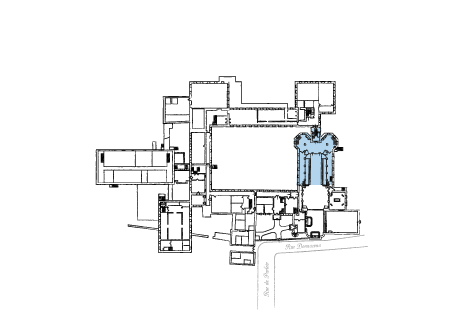Videos
Inner Chapel and Choir
The nuns and boarders attended Mass from behind the grill. It is called the inner chapel since it is part of the monastery, the home of the Ursulines. Its construction dates back to 1902, the same date as the outer chapel. Noting the numerous seats and benches, you may easily imagine the chapel filled with worshipers when the boarding school was at its peak. Nowadays, the public is welcome to attend Mass in this inner chapel.
Video
* The video you will see is a reduced version of the 3D model. The image quality is compressed to suit most devices.
Map - Ground floor

Transcription
Welcome to the inner chapel of the Monastery of the Ursulines of Quebec. We leave the tomb of Mary of the Incarnation and advance towards the center of the chapel.
A quarter-turn to the left to observe the place. From the center, we have a view of the altar of the Sacred Heart in the outer chapel. The chairs that you see on both sides are those that the nuns use today.
Let's move forward.
This wooden table is the main altar.
Turn to the left and go towards the corner of the chapel.
We are in front of the carved and gilded altar dedicated to Saint Joseph.
Let's turn to the right and go straight to the other corner.
We stand to face the other side altar. This altar is dedicated to the Virgin Mary under the name of Our Lady of Great Power. What is more particular is the story of the sanctuary lamp in front of the altar. Let us move back a little to observe it.
This lamp is a gift. A nun had prayed to Our Lady of Great Power to be validated in her vocation. She had promised, if her prayers were answered, to install a lamp that would never be extinguished. The Ursulines were careful to keep the flame alive until the lamp became electric.
Let's go to the back of the center aisle.
Let us look to the right and observe the grill that separates the private chapel, where we are, from the public chapel. In the past, a heavy grill occupied the whole wall and prevented access to the outer chapel. The Sisters attended Mass on this side, but the altar and the priest faced the outer chapel. Wherever private and public areas met, the sectors were separated by such grills. Throughout the ages, even heavier grills existed. This is the only one that has been preserved.
Back in the center aisle, we look up at the circular painting of the crucifixion placed at the top of the grill. This painting was a gift and designed specifically for this spot.
On the ceiling, above us, the bas-relief of the pelican, on one of the cupolas of the chapel. There are three cupolas in this part of the chapel. The pelican represents the gift of self. The dove represents the Holy Spirit and peace. Finally, the anchor represents the tenacity of faith.
Let us turn around to continue observing the ceiling and its cupolas.
Turn ninety degrees to the right and lower your gaze to the painting titled: “France Bringing Faith”. In this picture, France is represented by the queen who offers a religious painting to a native of New France. At the time, due to the difficulties of language, it was common to teach and evangelize with paintings.
Let's return to the back of the chapel. Above us, in the choir loft, towers a magnificent Casavant organ, a gift offered to the Ursulines by a group of former pupils.
We go back a little and look down to see the benches and stalls. The stalls are these large wooden armchairs. Formerly, this is where the nuns took their places for Mass and Divine Office. The novices were seated on the wooden benches in the center. The boarders sat in the balcony.
Walk to the right aisle.
Let us observe. We are in the forechoir. This area is reserved for the nuns. It is a passage between the wing where they live and the chapel.
Let us make a half turn to the left and face the altar.
This altar is dedicated to the Child Jesus. Sculpted and gilded, it occupies an important spot. It was formerly here that the novices received their religious names. It is also here that they stood in rank before entering the chapel.
Let us take a look at the portrait of the Holy Family. It is said that during the battles against the British, in order to support and protect the French army, this portrait was placed in the highest bell tower of the cathedral. On that day, the French troops won the battle.
Let’s make a U-turn.
We’ll take the little staircase that takes us upstairs, near the community room.













